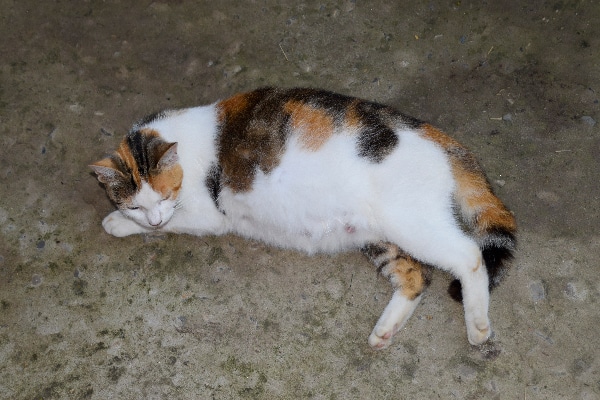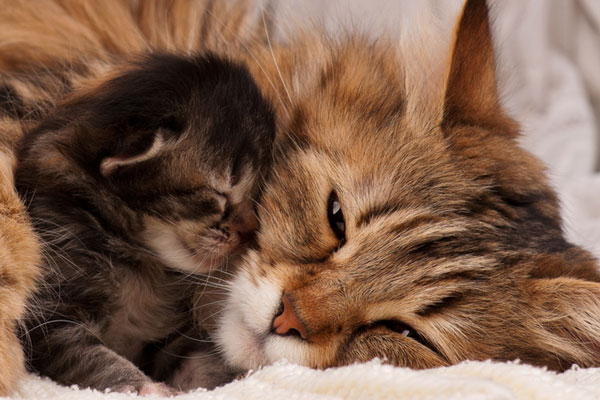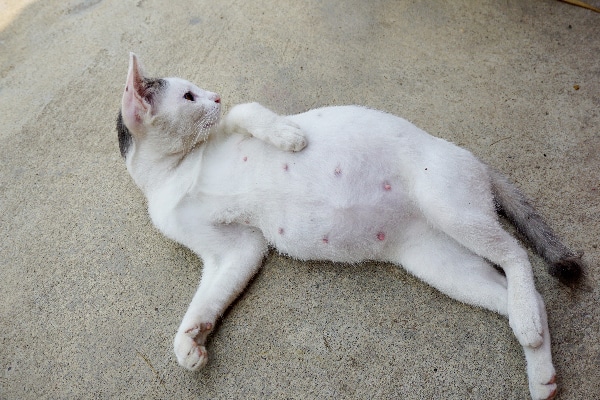We strongly encourage cat parents to spay and neuter their kitties to prevent cat overpopulation and health issues. That said, if a cat already has some babies in her belly — which is often the case if you find a stray female cat — here is what you need to know about and do for a pregnant cat.
How Can You Tell If a Cat Is Pregnant?

After a cat mates and conceives, the gestation period lasts a little more than two months: 65 to 67 days, roughly. A cat’s belly will not start showing much until a few weeks before birth, but a veterinarian might be able to feel kittens in the abdomen after at least three weeks. A pregnant cat’s nipples will turn a darker pink early in the pregnancy.
Cats show their individual personalities when they are pregnant, says Dr. Liza M. Guess, Assistant Professor – Practice at The Ohio State University’s Department of Veterinary Clinical Services in Columbus, Ohio.
“Some may become more affectionate and demand attention,” Dr. Guess says. “Some may become less tolerant of people and other pets — even ones they had gotten along with previously.”
How Do You Care for a Pregnant Cat?
While you are caring for a pregnant cat, do not give her any vaccines, and consult with your vet for proper treatment of parasites like fleas and worms. Feed the mama-cat-to-be a high-quality food that is labeled for growth/kittens, approved by The Association of American Feed Control Officials (AAFCO), and properly supplemented with taurine, Dr. Guess advises. Taurine deficiencies can cause fetal deformities or even death. It may be helpful to supplement with canned food to ensure the pregnant cat is getting enough calories, especially during the latter part of gestation.
You need to create a “queening” box, where your cat will make her nest and give birth. Find a warm place with a lot of privacy to put the queening box. You can use a cardboard box, laundry basket or other roomy container, and line it with things like blankets, sheets, newspapers and puppy pads.
“Use something you’re ready to throw away after you have kittens, because it’s going to be bloody and it’s going to be messy,” says Dr. Foote, owner of Okaw Veterinary Clinic in Tuscola, Illinois.
Ideally, Dr. Guess advises, a queening box should have raised sides, a side entrance that is off the ground and a removable lid. But cats being cats, your queen might not cooperate with your choice of birthing quarters.
“Of course, some will decide the box is not ideal and will think someplace like the middle of the owner’s bed is a good place to give birth,” Dr. Guess says.
How Do You Know When a Pregnant Cat Is About to Give Birth?
If you notice a vaginal discharge from your queen, she shows premature labor signs or you have any concerns about her condition, then take her to the veterinarian, Dr. Guess advises.
A day or two before giving birth, your pregnant cat will eat a lot less and will spend a lot of time in the box. When the labor time is imminent, your cat will start looking at her bottom, turning around and lying on her side. She may also get vocal, dig at the floor and get restless, or even aggressive, Dr. Guess says. Get ready — kittens are on the way!
Does a Pregnant Cat Need Human Help During Labor?
We humans tend to anthropomorphize with our pets. So, since most women want someone holding their hands in the delivery room while they give birth, wouldn’t a pregnant cat want her loving human petting and comforting her while she pops out kittens?
No, experts say. Unlike human women in labor, queening mother cats typically prefer solitude. Pregnant cats have different needs than pregnant humans, and they do a lot of the work – and with ferals, all of it — without our help, says Dr. Foote.
“Do not touch [a cat in labor] at all,” Dr. Foote advises. “Petting will shut a cat down. They don’t want you bugging them.”
“Most normal cats require no intervention at all,” Dr. Guess agrees. “Most cats would prefer to be left alone, so privacy would be best with some unobtrusive observation to monitor for signs of distress or problems.”
So, What Should You Do When Your Pregnant Cat Is in Labor?
Stay nearby when your cat is delivering. Also, keep a litterbox, food and water near the cat — when she is ready for it. The first kitten or two will come 5 to 10 minutes apart; after that, any remaining kittens may come with up to two hours in between, as the uterus gets tired, Dr. Foote says. A cat has a V-shaped uterus, unlike a human’s pear-shaped one. The queen might have two or three kittens on each side of the V, and the kittens further up the uterus will take longer to arrive.
You will see the bubble-like glossy amniotic sac appear at the tip of your kitty’s birth canal; the kitten will soon squeeze all the way out. The mother will then tear the sac and start licking the kitten, guiding the baby to her teats to start nursing. Meanwhile, she will continue to deliver kittens until she is empty.
The queen might let out a cry as she pushes out a kitten, but if she is really shrieking, seek immediate veterinary attention. Also, get medical attention if the cat is actively pushing for several minutes and the kitten is stuck. In some cases, you can help move a larger kitten along by holding a towel up to the cat’s vagina and under the baby. This gives the baby some traction.
How Long Does Cat Labor Take?
Delivering a litter of kittens can take up to 24 to 48 hours. Your queen, if stressed, can experience “interrupted labor,” which stops birth for a while and resumes later. But most of the time, the delivery will take four to eight hours, Dr. Guess says.
You can’t always tell conclusively whether any kittens remain in your cat’s womb. But if your queen starts eating and drinking, that almost always means she is done, Dr. Foote says.
“During labor, the GI tract shuts down: Everything in her body is focused on those kittens and getting them out to the world,” Dr. Foote says. “She doesn’t want to eat; she doesn’t want to drink.”
Wondering what exactly happens during cat labor? These videos are very graphic (warning!), but show you exactly what happens during cat labor:
What to Do After Your Cat Gives Birth

Like a cat in labor, give your new mama cat some space and privacy after she has her kittens. However, Dr. Guess says, some mothers might want more attention from their humans. Don’t handle the delicate babies at first. Wait at least until their eyes open, which happens on average in seven to 10 days. Keep feeding your mother cat kitten food while she is nursing and let her eat all she wants. She needs the extra calories and nourishment to feed herself and her new babies!
Keep the queening box clean without disturbing the babies too much. You will need to change the lining frequently. Look for signs that the new mother and her kittens need medical attention. If the mom is not urinating and defecating normally, eating and drinking well, or making much milk — and, if the kittens aren’t thriving and gaining weight — take the mom and her litter to a veterinarian.
And, most importantly, take your mama cat to the vet for a spay once the vet says she’s physically ready.
Take Your Cat to a Vet Immediately If Any of These Things Happen Before or During Labor
Dr. Guess recommends taking a pregnant cat to a vet immediately if these things happen before or during labor:
- Gestation prolonged beyond the expected date of delivery
- Prolonged non-progressive preparations for birth
- Vigorous straining for 20 to 30 minutes without fetal delivery
- Weak, intermittent straining for one to two hours without fetal delivery
- An interval of two hours between fetuses
- Fetus apparently stuck in the birth canal and partially visible
- A red-brown discharge but no fetus delivered
- Delivery of dead kittens
- Cessation of birth process, but you think some fetuses remain undelivered
- Signs of maternal illness, distress or unexpected blood loss
Thumbnail: Photography ©Doucefleur | iStock / Getty Images Plus.
Read more about pregnant cats and cat reproduction here:








